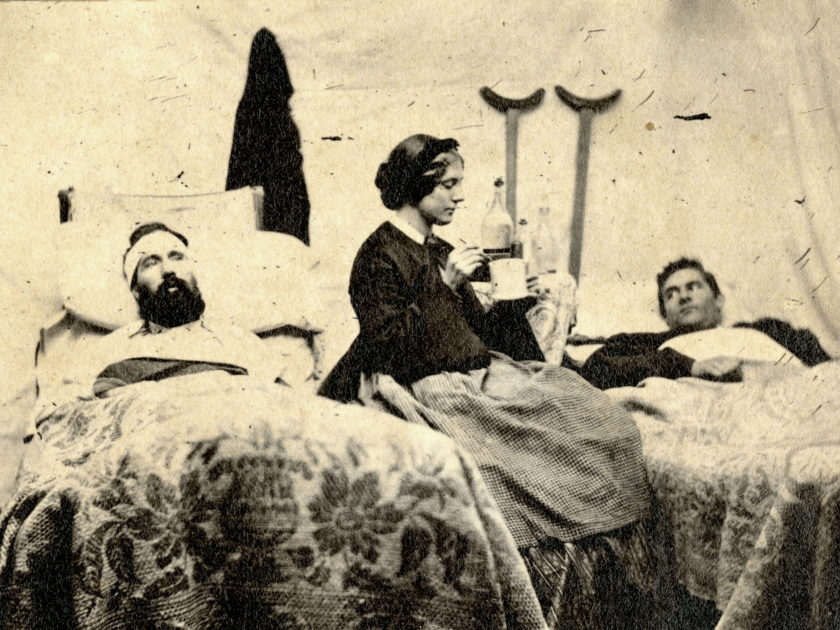By Chris Foard, MSN, RN
Nurse Annie Bell was exhausted after another long day tending to her endless duties at a military hospital in federal-occupied Nashville.
“I have just come in from my ward, and am so tired, that if I was at home I could go to bed,” she wrote to her mother, Eliza, on Feb. 15, 1864. Despite fatigue, Bell finished the letter with the certain knowledge that it may be awhile before she had another opportunity.

Today’s Civil War scholars will be grateful that Bell took the time to write. In the letter, she shares her motivations, concerns and emotions about posing for one of the war’s iconic photographs. And, tucked into the tattered envelope with the letter is her personal copy of the carte de visite of the scene published in countless books and on websites and other media.
I discovered the letter in a cache of personal documents acquired from a military relics dealer in 2005.
Bell’s four-page letter follows a familiar pattern in writings by nurses and soldiers on both sides of the conflict. She begins with apologies for delays in writing, and wonders why letters from home are not forthcoming. This is followed by news about her situation. Then, a final section offers advice and comments about affairs back home in Blair County, Pa., about halfway between Pittsburgh and Harrisburg.
The middle section of her letter however, holds particular interest. Here, Bell explains how she came to pose with patients for the U.S. Sanitary Commission, which sold untold numbers of her carte de visite at well-attended fairs in Northern cities. Proceeds from the photo sales funded the Commission’s budget. She also mentions Ellen Orbison Harris, secretary of the Philadelphia Ladies Aid Society and a fellow nurse.
“It makes me laugh to think of becoming saleable—and folk’s making money out of me, I dont mean that it gives me any pleasure, but makes me feel very strangely.”
“I send you a picture, one of the persons you will perhaps recognize. Two weeks ago, some of the Sanitary Commission people came to see me & asked that I would allow an artist to take a hospital scene, that they wanted such a one to sell at the fair at Cleavland. At once I said no, that I could not consent to becoming so public but they said if I did not wish they should not tell my name but only the hospital & what ward—so for the benefit of the soldiers, I consented—and now there is quite a rage for the picture, Mrs Harris declares she must have some to sell in Phila, & Huntingdon, but I said they must not go any where where I am known. It makes me laugh to think of becoming saleable—and folk’s making money out of me, I dont mean that it gives me any pleasure, but makes me feel very strangely.”
Bell did not mention the names of the two patients pictured with her. Their identities remain a mystery.
One week after Bell wrote her mother, on Feb. 22, George Washington’s birthday, the Northern Ohio Sanitary Fair opened in Cleveland. The 16-day event resulted in revenues of about $78,000 for the Commission. Though period accounts do not mention her image, one can assume that the photograph was sold at the fair and elsewhere.
All things considered, it is perhaps understandable that Bell found it difficult to describe her emotions. She was part of the first generation to grow up with photography, and using the medium as a tool for promotions was in its infancy. Moreover, she and other women lived during a time when traditional roles were upended by the collision of Victorian attitudes with reform movements and industrialization.
In today’s world, however, Bell would likely have been exposed to the concepts of personal branding and the practices of modern philanthropies.
While some may have been negatively affected by change and fleeting celebrity status, Bell appears to have taken her experience in stride. She went on to serve as matron of General Hospitals No. 1 and No. 8 in Nashville until the end of the war. While there she met Asst. Surg. George Eastman Stubbs, and they married in September 1865. She raised a family, travelled, and became a dedicated member of the National Association of Army Nurses of the Civil War, which met each year as part of the Grand Army of the Republic encampments.
Bell died in 1916 at age 76. Three daughters and a son survived her.
Chris Foard, MSN, RN, is owner of The Foard Collection of Civil War Nursing. He is currently exhibiting his Mansion House Hospital items at the Carlyle House in Alexandria, Va., for the Mercy Street exhibit.
SPREAD THE WORD: We encourage you to share this story on social media and elsewhere to educate and raise awareness. If you wish to use any image on this page for another purpose, please request permission.
LEARN MORE about Military Images, America’s only magazine dedicated to showcasing, interpreting and preserving Civil War portrait photography.
VISIT OUR STORE to subscribe, renew a subscription, and more.

